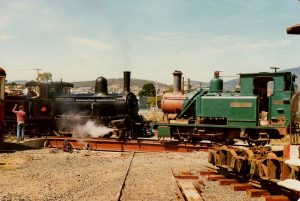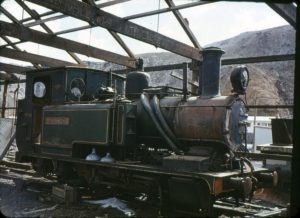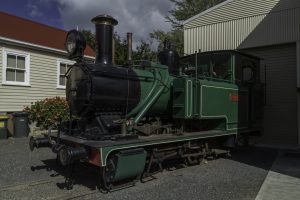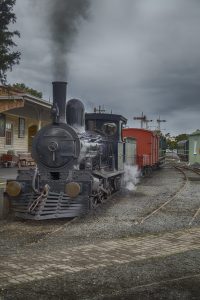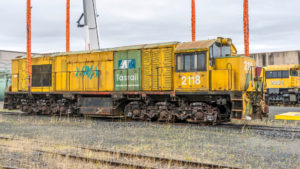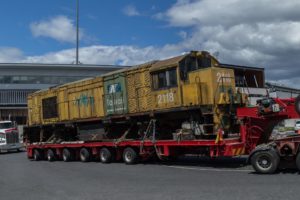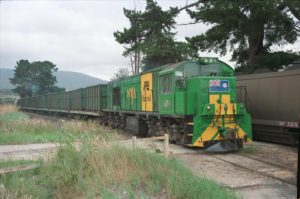C22
C22 was built in 1902 for the Tasmanian Government Railways (TGR) by the Beyer, Peacock & Company in England. 27 were purchased between 1885 and 1907, with C28 being purchased from the Public Work’s Department in 1937. In addition to the Tasmanian locomotives, many similar locomotives were built for most other mainland states.
C22 operated throughout Tasmania on a variety of train types and it last ran at Wynyard during October 1960 and ran 882,188 miles until it was withdrawn from service. C22 was purchased by the museum in 1967 and was restored to running order for the opening of the museum in 1983. C22 operated passenger trains on the museum demonstration line up until 1999 when it was withdrawn from service for boiler repairs. Work was finally completed in late 2009 and it re-entered service in mid 2010. C22 continues to operate passenger trains on the museum’s demonstration line.
Preserved: 2
Boiler Pressure: 140 lbs
Tractive Effort: 12076 lbs
Wheel Arrangement: 2-6-0 Tender
Manufacturer: Beyer, Peacock & Company
Weight: 48t
Water Capacity: 1700 gallons
Click on the link to see C22 on the demonstration line here.
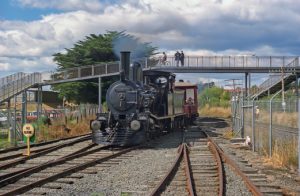
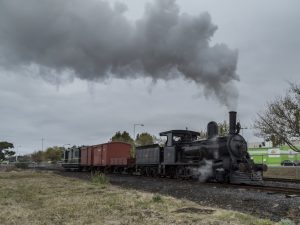
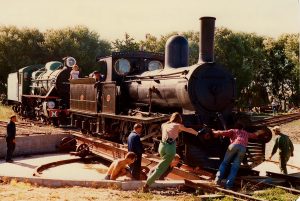
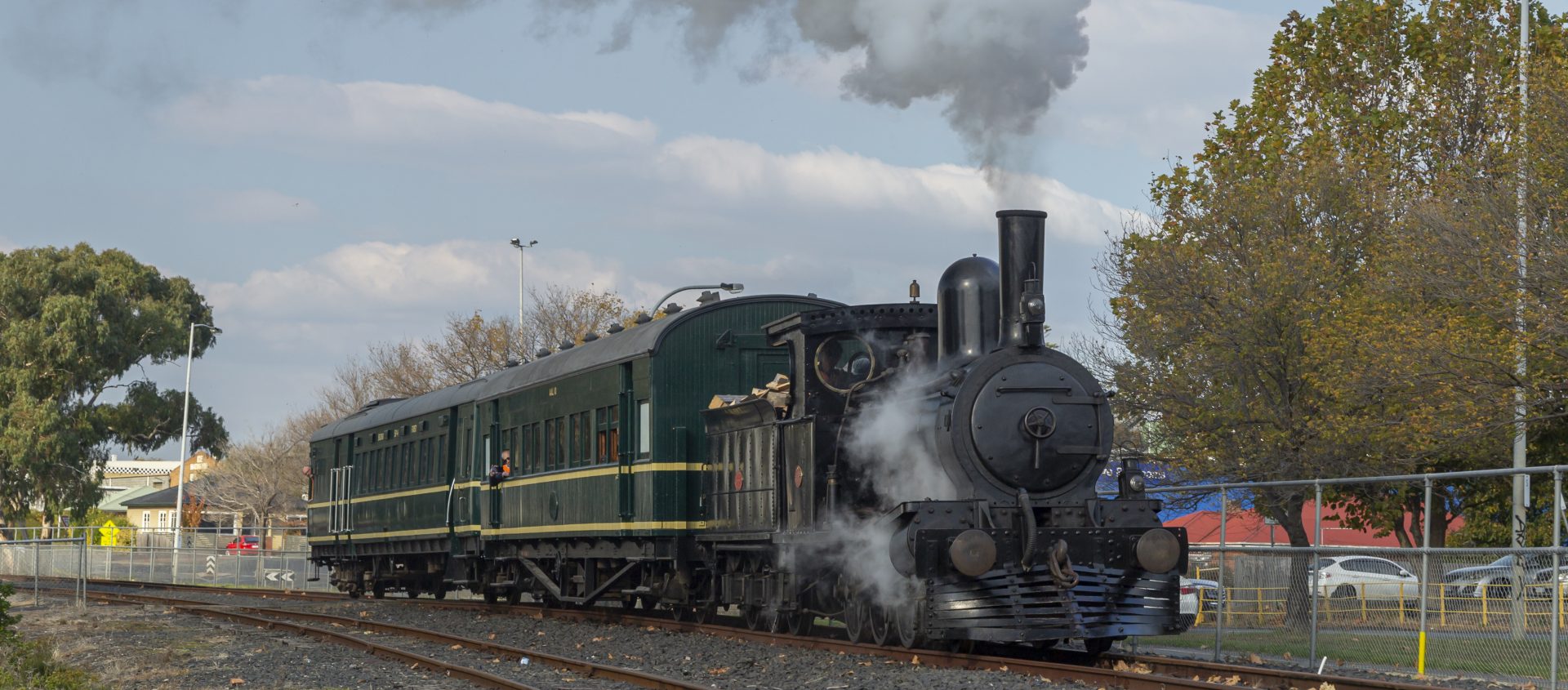
M5
M5 was built in 1952 by Robert Stephenson and Hawthorns Ltd of Darlington, England. A total of 10 were purchased by the Tasmanian Government Railways (TGR), with M5 entering service on the 26 May 1952. M5 spent much of its life working trains in northern Tasmania. From 1962 M5 was used only spasmodically, including various periods spent working out of Hobart, with its last major run being on a special train from Launceston to Hobart in March 1971. Despite having had a recent boiler examination, M5 was relegated to steam cleaning duties in Hobart in June 1971, but when M6 became the Hobart steam cleaner, M5 was stored outside the locomotive roundhouse. M5 was donated to the museum in November 1974 and was delivered to the museum in October 1976, where it was repainted for static display.
In 1992 museum members began a major boiler overhaul of M5, including the fitting of new boiler tubes, with a view to returning the locomotive to mainline service. M5 was first steamed under museum ownership on 15 July 1995 after 24 years out of use and was certified for use in October 1995. The first mainline run of the locomotive took place on 26 April 1996.
Since that time M5 has operated on the museum demonstration line and operated over the Tasrail network such as to Launceston, National Park and the Hobart Suburban Line.
M5 is currently undergoing a 10 yearly boiler inspection and overhaul which will include new axle bearings and new tyres fitted. It is expected M5 will return to service in late 2020.
Preserved: 10
Boiler Pressure: 180 psi
Tractive Effort: 17 090 lbs
Wheel Arrangement: 4-6-2 Tender
Manufacturer: Robert Stephenson & Hawthorn
Weight: 96t
Water Capacity: 4000 gallons
Click on the link to see M5 on the demonstration line here.
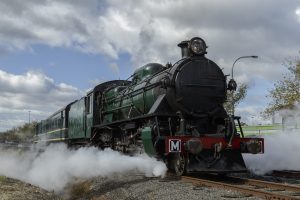
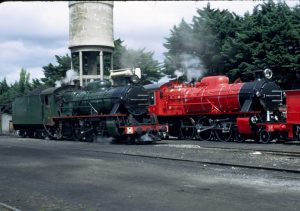
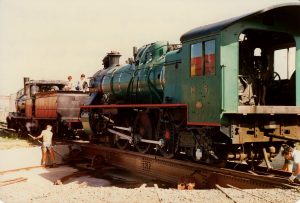
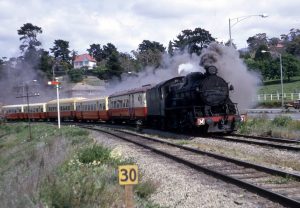
H1
H1 was built in 1951 at the Vulcan Foundry Limited in Lancashire, England, the first of 8 locomotives ordered by the Tasmanian Government Railways (TGR) and it entered service on 7 November 1951. The H class were intended to complement the aging Q class locomotives however with the order of 32 X class diesel electric locomotives in 1950, the H class had a relatively short operational life in Tasmania. The H class were restricted to the northern parts of the rail system due to the tight curves on the south line up until the mid 1960s. After the enlargement of the Rhyndaston tunnel and alteration of the flange arrangement of the driving wheels on the remaining serviceable H class, they were allowed to run unrestricted south of Parattah from the mid 1960s through to Hobart and the Derwent Valley Line.
H1 was stored in June 1962 having ran 153,428 miles in just over 10 years of service. H1 was donated to the museum in 1974, and was subsequently restored to its original condition as a static exhibit. H1 had spent the majority of its preservation in the same display location, in 2016 it was moved and placed alongside Q5.
Preserved: 5 plus 1 underframe
Boiler Pressure: 200 psi
Tractive Effort: 27 540lbs
Wheel Arrangement: 4-8-2 Tender
Manufacturer: Vulcan Foundry, Newton-Le-Willows, England
Weight: 110t
Water Capacity: 4000 gallons
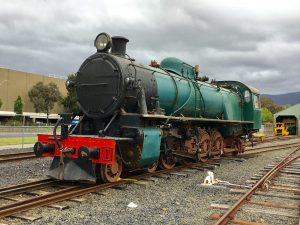
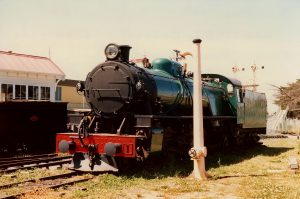
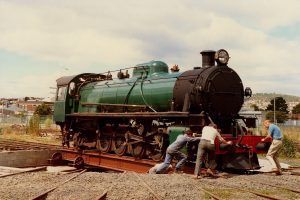
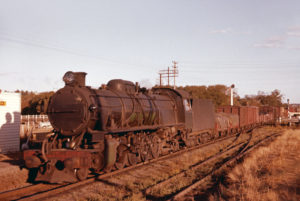
Q5
Q5 was built in 1922 for the Tasmanian Government Railway (TGR) and entered service in February 1923 and was one of the first order of six Q class locomotives delivered by Perry Engineering of Adelaide in 1923. A second batch, of three locomotives, was obtained from Walkers Engineering of Queensland in 1929. A third order, this time of six locomotives was later obtained from Clyde Engineering of NSW. A final batch of four was ordered from Clyde in 1940, but due to the Second World War, only two locomotives were in service by 1944. The TGR completed the assembly on the final two locomotives in 1945, from parts supplied by Clyde Engineering.
Initially the Q class were restricted to operating between Hobart, Launceston and Devonport. By the time the last locomotives were delivered track upgrading had meant that they were able to operate on the Main, Derwent Valley and Fingal lines, and the Western line as far as Wynyard.
After introduction of the X class diesel electrics the TGR significantly rationalised its locomotive fleet and in April 1962, Q5 was withdrawn from service and ran 955,876 miles. With most of the Q class being scrapped in Launceston in 1965 the then newly established Tasmanian Transport Museum purchased Q5 for £350 and it was transferred to Hobart and stored in the Hobart Roundhouse until it was eventually delivered to the museum in October 1976. Q5 has been cosmetically restored.
Preserved: 1
Boiler Pressure: 160 psi or 180 psi
Tractive Effort: 27200 lbs
Wheel Arrangement: 4-8-2 Tender
Manufacturer: Perry Engineering, South Australia (Q1-6); Walkers Engineering, Queensland (Q7-9); Clyde Engineering, NSW (Q10-15, Q16-19)
Weight: 103t
Water Capacity: 3500 gallons
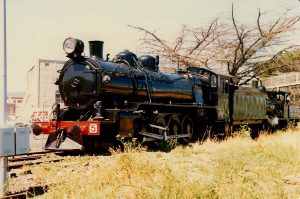
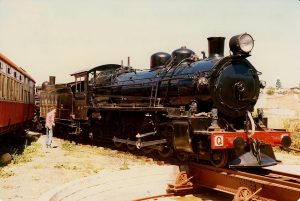
1653
Climax 1653 is a standard B type locomotive which was built in 1923 by the Climax Manufacturing Company in Pennsylvania, USA for the firm of John Chambers and Sons of New Zealand. It is doubtful that the locomotive ever went to New Zealand, as it was known to have been working on the tramways of Pines and Hardwoods Ltd in the Simmsville area of NSW by 1925 with other A and B-type Climax locomotives. 1653 was sold to the Australian Newsprint Mill and arrived in Tasmania from New South Wales during 1941 and was modified in the Emu Bay Railway workshops before entering service hauling log wagons along the five kilometre long spur line between the Tasmanian Government Railway’s Derwent Valley Line and the log loading areas in the Tyenna and Styx valleys.
Unlike a conventional steam locomotive, in which the driving wheels are mounted in a rigid frame, the B-type Climax locomotive has two four-wheel bogies on which all axles are driven by a system of bevel gears, tailshafts and universal joints connected to a transverse shaft. This shaft is powered by inclined cylinders mounted on both sides of the locomotive. The bogies support the loco underframe on which is mounted the boiler, cab and water tank.
The Climax had a short working life in Tasmania and the locomotive was taken out of service in 1949 and was left on a short length of track at the western end of Florentine yard. Eventually the locomotive was donated to the museum by paper making company Australian Newsprint Mills, and was delivered to the museum in 1977. The successor of Australian Newsprint Mills (Fletcher Challenge) made a substantial donation towards the cost of cosmetically restoring the locomotive in 1998.
Preserved: 1 in Tasmania
Boiler Pressure: 200 psi
Tractive Effort:
Wheel Arrangement: B – type
Manufacturer: Climax Manufacturing Company
Weight:
Water capacity:
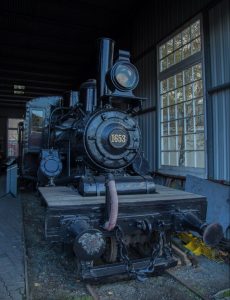
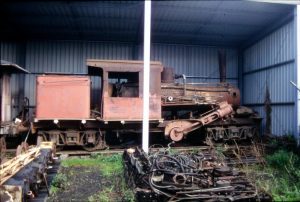
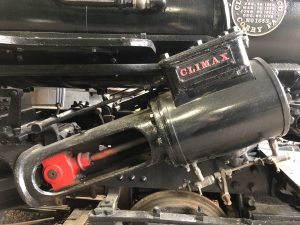
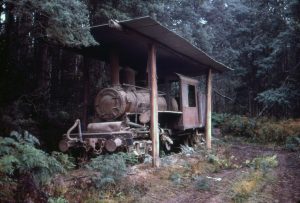
Vertical Boiler
Built in 1889 by Markham and Co. Ltd in Chesterfield, England, at their Broad Oaks works in Chesterfield, England, and was the only 3’6”gauge vertical-boilered loco built by that company. It was fitted with cast iron wheels with 7”(175 mm) wide treads and 2” (50 mm) deep flanges, making it suitable to work over rough bush tramways such as those laid with logs rather than conventional steel rails. The vertical boiler was fuelled by firewood, and was particularly useful for working on steep terrain compared to a typical horizontal boiler. The engine was a two-cylinder vertical type with a cog wheel on the crankshaft which meshed into another mounted on one of the two axles of the loco. Outside connecting rods made all four wheels powered. The locomotive weighed just under 7 tonnes.
The first recorded use of this locomotive in Tasmania was in 1898, on the tramway for Hay’s Mill at Hastings. Around 1918 the locomotive was transferred to the tramway between the Weilangta mill and Rheban on the east coast. In March 1911 the locomotive was fitted with a new boiler constructed by Cowley’s of Ballarat, Victoria. The locomotive was again transferred about 1936, this time to Sharp’s mill beside the Tyenna River near National Park, where it saw limited use hauling sawn timber from the mill to Sharps Siding on the Tasmanian Government Railways (TGR) Derwent Valley Line. The boiler was later removed from the frame of the locomotive for use elsewhere, but was refitted before the loco was taken to the end of the tramway in the hills above the Tyenna River, where it provided steam to drive a water pump. The locomotive and boiler were abandoned in about 1946, and in February 1983 museum members transferred it to the museum. Restoration work on the locomotive commenced in 1987 and was largely completed in 2003. It is probably the last surviving vertical-boilered locomotive in Australia.
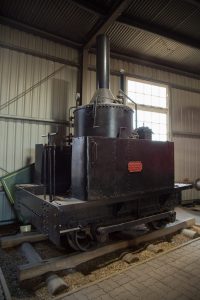
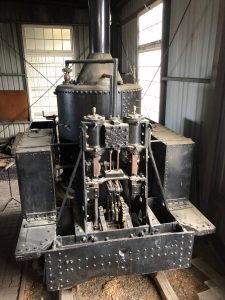
X1
X1 was built in 1950 by the Vulcan Foundry Limited, England, the first of 32 ordered by the Tasmanian Government Railways. On 13 September 1950, locomotives X1 and X2 entered service in Tasmania, becoming Australia’s first mainline, diesel-electric locomotives. The final 12 X class were built at English Electric’s Dick Kerr Works.
The introduction of the 32 X class locomotives resulted in the demise of most steam locomotives from service. Up until 1973 the X class formed the backbone of the Tasmanian Government Railways (TGR) locomotive fleet but with the introduction longer heavier trains and more powerful locomotives, the X class soon became less useful for new owners of the rail system, Australian National Railways (ANR). This resulted in the gradual withdrawal of the class. X10 and X18 being the last in service, not being sold until August 1988.
X1 was rebuilt in 1955 at the railways Launceston Workshop following a serious accident on the evening of 26 October 1951. X1-X2 hauling a northbound goods train went down the bank at the horseshoe bend north of Danby in the southern midlands. Everything but the DB Guards van went down the bank, sadly killing the locomotive crew.
X1 survived through the early 1980s in mostly original condition, not receiving the automatic couplers and modified cab windows fitted to most other class members. With a declining need for vacuum-braked locomotives X1 was withdrawn in April 1985 when requiring minor repairs. Because of the loco’s historical significance Australian National Railways presented X1 to the museum for permanent loan on 20 October 1985. With the sale of the Australian National Railways to private owners in 1997, ownership of X1 was officially transferred to the museum. X1 was repainted into the Red and Cream livery and has had limited use at the museum since it first arrived, but is now out of service due to poor mechanical condition.
Preserved: 7
Type: Bo Bo
Manufacturer: Vulcan Foundry Limited (X1- X20) English Electric Dick Kerr Works (X21-X32)
Motor: EE 6SRKT 660HP
Total Weight: 58t
Load 1: 40 grade: 210t
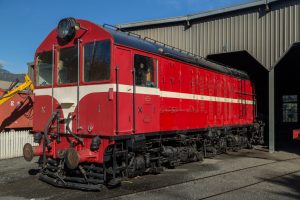
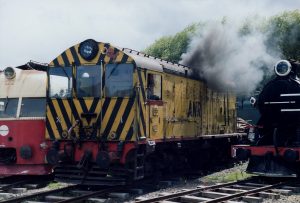
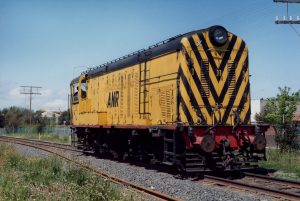
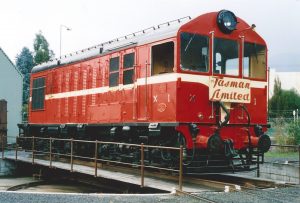
Y4
Y4 was built in 1964 by the Tasmanian Government Railways (TGR) at their Launceston workshops and entered service on 20 October 1964. It was built to a standard English Electric design and used traction equipment imported from England. Y4 was named Rowallan after Lord Rowallan, who had just finished his term as the Governor of Tasmania.
Y4 operated all over the state on passenger and goods trains up until it was withdrawn from service in November 1989. It was stored in Launceston until it was offered to the museum on loan and towed to Hobart on 16 June 1994 and was placed in the Tasrail Hobart workshop where restoration commenced. Y4 had been heavily vandalised during storage in Launceston and parts had been removed and required refitting. Y4 was started for the first time since 1989 on 2 August 1994.
On 3 April 1996, Y4 ran light engine from Hobart to Glenorchy, where it passed over a newly installed crossover and onto the museum track. Over the next four years restoration continued and it was repainted in the Red and Cream livery. In March 2003, Y4 operated its first mainline excursion since being restored. Since then it has operated a number of mainline excursions and was on 3 months hire to the Don River Railway which saw Y4 operate on the Melba Line to Rosebery. In May 2018 Y4 operated passenger trains on the museums demonstration line for the first time as part of the Diesel Day event.
Preserved: 8 (1 as a driving van)
Type: Bo Bo
Manufacturer: Tasmanian Government Railway
Motor: EE 6SRKT 800HP
Total Weight: 59t
Load 1: 40 grade: 360t
Click on the link to see Y4 on the Tasrail mainline here.
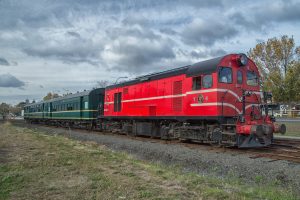
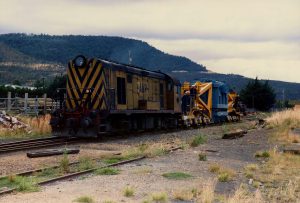
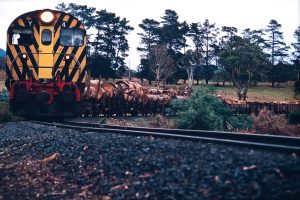
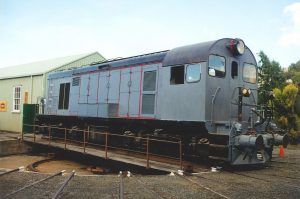
ZA6
ZA6 entered service in June 1976, being built at the General Electric Corporation factory in Rocklea, QLD and joined the other five ZA locos and the four Z class hauling heavy log and goods trains across the north of the state, later working the south as well. At the time of its entry into service, the Tasmanian Government Railways had been transferred to federal government ownership though was still under state control until the Australian National Railways Commission took over in March 1978.
A decision was later made to convert train braking systems from vacuum to air brakes, accordingly ZA6 had this brake conversion made during a major overhaul in late 1983/early 1984. The conversion included the removal of the original retractable buffers from the headstocks and was the only major modification made to the locomotive in its working life. It was repainted into the ANR Tasrail green and yellow colour scheme at Launceston workshops in April-May 1988, this repaint included the unique additions of logos on the long hood sides and Tasmanian flags on the front and rear panels of the loco’s body which commemorated the bicentenary of the British colonisation of Australia. In November 1989 the metal cabside numbers and builders plates were replaced with large yellow painted numbers ZA6/N, the letter N denoting a computer check letter which the Z type locomotives carried at the time.
Prior to the sale of the rail network to the Australian Transport Network in November 1997, ZA6 was repainted in the yellow and green ‘reverse’ colour scheme at East Tamar Junction in late December 1996/early January 1997, which included the retention of most of the bicentenary markings. Under ATN ownership it was renumbered as 2118 in mid July 1998, by which time it was also carrying ATN logos on the hood sides in place of the former ANR logos. 2118 remained in service after Pacific National Tasmania took over the ATN operations in 2004 but was withdrawn from service on 3 July 2005 after which its traction motors were removed for reuse in other locomotives. The motors were not replaced and 2118 remained in storage at the East Tamar workshops, losing some other fittings over time for use on other locomotives.
After the rail system returned to government ownership 2118 was added to a list of locomotives to be scrapped in June 2012, however after representations from preservation groups the loco was retained for possible preservation. A bogie change with one of the sister ZAs going for scrap meant a full set of traction motors were restored to 2118. After the new TR class locomotives entered service during 2013 and 2014, 2118 joined a long line of withdrawn English Electric and General Motors powered locomotives stored in the Showgrounds track at East Tamar.
Following some years of storage 2118 was returned to the workshops yard on 1 December 2020 on the first leg of its journey to the Transport Museum. The locomotive body and separated bogies were lifted by cranes onto low loaders on 13 January 2021 and on the following day 2118 was lowered onto the museum tracks at Glenorchy. Attention then turned to restoring the loco to again become ZA6 wearing the 1988 bicentenary livery.
On 11 November 2023, ZA6 was successfully started for the first since 2005 and moved a few metres under its own power. See the full length video here.
Builder: General Electric Corporation (GEC) – Heavy Engineering Division
Preserved: 2 in Tasmania (1 in storage at East Tamar)
Introduced: 1976
Number in class: 6
Motor: EE 12CSVT MK III
Total Weight: 96t
Load 1: 40 grade: 675t
Ruston
The Ruston locomotive was built in 1950 by the Ruston and Hornsby Company of England for the Electrolytic Zinc Company of Australasia Ltd to assist in the shunting of the railway yards at their Rosebery mine. It is a standard 48DS model fitted with narrow gauge wheels to suit its use in Tasmania. The Ruston (builders number 284836/1950) spent most of its life shunting around the Rosebery mine yard until the advent of block ore trains and the cessation of general goods traffic removed the need to shunt small groups of wagons. The locomotive saw little use from the mid 1970’s, spending most of the time locked in the goods shed at Rosebery station having been replaced by the larger six-wheeled Vulcan-Drewry shunter numbered 22. The Ruston was transferred to the Emu Bay Railways Burnie workshop in 1997 where it was repainted into the Emu Bay Railway colours for the Centenary celebrations that same year, having originally been painted in the standard Ruston dark green.
Shortly after the sale of the Emu Bay Railway (EBR) to Australian Transport Network (the new owners of Tasrail) was announced, the Ruston locomotive was donated to the museum by Pasminco, the owners of the Rosebery mine and the EBR, and was trucked to the museum on the 16 April 1998. The loco is fully operational and used for shunting rolling stock around the yard.
Builder: Ruston and Hornsby Company
Preserved: 1 in Tasmania
Type: – B-
Introduced: 1950
Number in class: 1
Motor: 88 hp
Total Weight: 18t
Click on the link to see the Ruston shunting here.
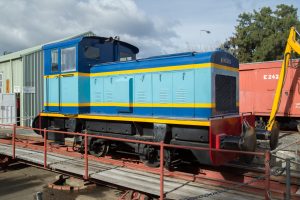
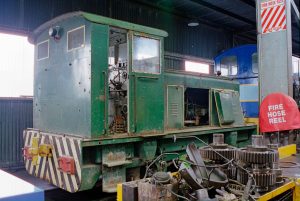
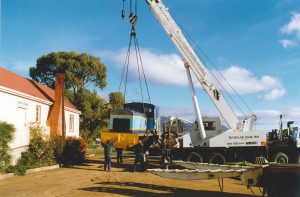
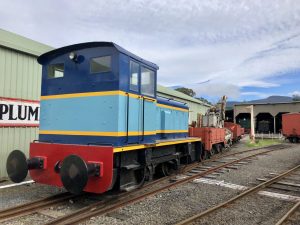
ABT No.2
Note: The locomotive is no longer owned or displayed by the museum.
Four ABT locomotives were built for the Mt Lyell Mining Company by Dubs and Company, Scotland and entered service between 1896 and 1901. A fifth locomotive entered service in 1938. The 35 km railway carted minerals from the Queenstown mine to Strahan for shipment overseas. The terrain between Queenstown and Strahan comprises steep, rain-forest covered ridges and fast flowing rivers and the construction of a conventional railway would have been expensive and very difficult. The Mt Lyell Mining Company decided to build a 3’6 (1076 mm) gauge railway which included two sections of rack-assisted inclines, one section being 2.4 km long (1 in 16 grade track) and the second section being a 4.8 km long (1 in 20 grade track). The two rack sections of track used the ABT system, which comprised a pair of toothed rails mounted midway between the conventional 3’6 rails. The rack rails are engaged by two pinion wheels built into the locomotive, these pinion wheels being powered by a separate pair of steam cylinders to those powering the locomotive driving wheels. During the 1940s and 1950s the ABT locomotives were fitted with electric generators and lights, larger sandboxes and were converted from coal to oil fired. The railway closed in 1963 as the line required large expenditure. Fortunately, four of the locomotives were preserved, with ABT No.4 being dismantled and scrapped.
ABT No.2 was obtained by the museum as static exhibit and is currently the only engine in original 1960s condition. ABT No.1, No.3 and No.5 have been rebuilt for use on the West Coast Wilderness Railway and are once again hauling trains between Queenstown and Strahan. In October 2019, ABT No.2 was purchased by the West Coast Wilderness Railway and left the museum by truck on 6 November 2019.
Click on the link to see ABT No.2 being moved around the museum here
Click on the link to see ABT No.2 leaving the museum in November 2019 here
